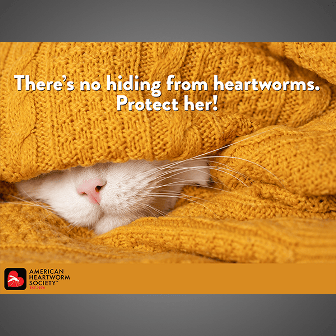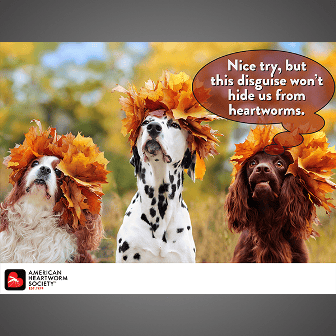Revised Guidelines Stress Risk Analysis in Prevention, Testing and Treatment Decisions
Wilmington, Delaware—Reducing heartworm transmission, clarifying testing recommendations and avoiding shortcuts in heartworm treatment are priorities of the 2018 canine heartworm guidelines recently released by the American Heartworm Society (AHS). The guidelines, which focus on heartworm prevention, testing and treatment, as well as heartworm biology and epidemiology, are used by thousands of veterinary practices to guide their clinical protocols and day-to-day decisions about heartworm management.
Revisions to the AHS guidelines are published as needed, based on assessment of heartworm research that impacts principles of heartworm management. The 2018 guidelines have just been released and reflect the following updates to the Society’s recommendations.
Heartworm Prevention: Weigh the Relative Risk
Given the highly preventable nature of heartworms, prevention practices are the cornerstone of any practice’s heartworm management program, says Chris Rehm, DVM, President of the American Heartworm Society. “Unfortunately, the latest AHS survey found that incidence has been trending up rather than down, with the number of infected dogs per clinic rising by 21 percent in the U.S. and its territories between 2013 and 2016.”
Environmental and climatic changes, as well as the relocation of microfilaremic dogs and the expansion of microfilaremic wild canid territories are considered to be contributing factors to both incidence numbers and the spread of heartworms to areas once considered non-endemic. Effective prevention also requires diligence in compliance on the part of pet owners.
“For these reasons, we continue to stress the importance of year-round administration of macrocyclic lactone (ML) preventives, along with practical steps to reduce mosquito exposure, such as eliminating standing water on the property and keeping pets indoors during peak mosquito times,” says Rehm. “Year-round prevention is the single most important step owners can take to reduce the risk of heartworms to their pets.”
In an update to their prevention recommendations, the AHS Guidelines state that veterinarians should also consider the use of EPA-approved mosquito repellents/ectoparasiticides to control the mosquito vector and reduce heartworm transmission if the risk of heartworm transmission is high.
“The use of repellents is not a blanket recommendation, nor should repellents ever be used in place of ML preventives,” stresses Rehm. “In regions with relatively low heartworm incidence numbers and few mosquitoes, use of heartworm preventives alone can be sufficient to safeguard patients. Where mosquito proliferation and heartworm incidence numbers are high, however, additional measures may be warranted on either a year-round or seasonal basis. Individual veterinarians are in the best position to assess the risk for their practices as well as for individual patients.”
Heartworm Testing: Putting Heat Treatment in Perspective
Studies have been conducted over the past decade to better understand the potential for heat treatment of serum samples to unmask blocked antigen, raising questions about optimal heartworm testing methods. While noting that further study of this effect is warranted to better understand the mechanisms in play, the AHS Guidelines affirm that the high sensitivity of antigen and microfilaria tests make heat treatment unnecessary for routine heartworm screening.
“This doesn’t mean there isn’t a time and place for this practice in heartworm diagnosis,” Rehm notes. The AHS Guidelines recommend veterinarians consider heat treating serum when either the presence of circulating microfilariae is detected or the veterinarian suspects active clinical disease in the absence of a positive antigen test.
Heartworm Treatment: Stick with the AHS Protocol
“One of the most frequent questions we hear—especially from pet owners—is about the need from adulticide treatment for infected dogs. It’s understandable when you consider the expense of treatment and the need for multiple veterinary visits,” says Rehm. “We also get questions from veterinarians about the AHS protocol itself, which includes pretreatment with an ML and doxycycline, followed by a month-long waiting period, then three doses of melarsomine on days 60, 90 and 91.
“Heartworm disease is a complex disease, and there are no shortcuts to appropriate treatment,” the AHS leader emphasizes, noting that the AHS protocol was designed to kill adult worm infections with minimal complications while stopping the progression of disease. “Skipping any one of these steps can affect both the safety and efficacy of heartworm treatment.”
Rehm adds that non-arsenical treatment protocols, including the “moxy-doxy” combination of moxidectin and doxycycline, have been studied in both Europe and the U.S. to better understand how to manage heartworm-positive dogs that aren’t candidates for melarsomine treatment. “Because some dogs are simply not candidates for adulticide treatment, there is a place for alternatives such as these,” he explains. “However, it’s also important for veterinarians to understand that these non-arsenical protocols have serious disadvantages, the most important of which is the length of time required to kill adult worms, during which time heartworm pathology and damage can progress. This also greatly increases the length of time the pet needs strict exercise restriction, which is problematic.”
In a 2017 AHS survey of approximately 5,000 veterinarians, three-quarters of practitioners stated they follow the AHS heartworm guidelines. “As the primary heartworm resource for veterinary practitioners and the public, it’s our job to continually assess new information on heartworm management and adjust our guidelines accordingly,” Rehm concludes. “Our hope is that the 2018 updates will clarify what veterinarians can do day-to-day to reduce the threat of this significant disease.”
To access the complete set of AHS canine and feline heartworm guidelines, visit heartwormsociety.org.
About the AHS
Founded during the Heartworm Symposium of 1974, the American Heartworm Society (AHS) aims to further scientific progress in the study of heartworm disease, inform the membership of new developments and encourage and help promote effective produces for the prevention, diagnosis and treatment of heartworm disease. Information and resources on heartworm disease can be found at heartwormsociety.org, while an online treatment app can be found at heartwormtoolkit.com.








